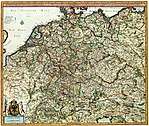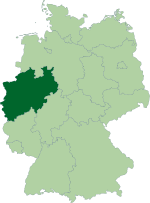Timeline of Münster
The following is a timeline of the history of the city of Münster, North Rhine-Westphalia, Germany.
Prior to 19th century
Part of a series on the |
||||||||||
|---|---|---|---|---|---|---|---|---|---|---|
| History of Germany | ||||||||||
 | ||||||||||
| Topics | ||||||||||
| Early history | ||||||||||
| Middle Ages | ||||||||||
| Early Modern period | ||||||||||
| Unification | ||||||||||
|
||||||||||
| German Reich | ||||||||||
|
||||||||||
| Contemporary Germany | ||||||||||
|
||||||||||
|
| ||||||||||
- 797 - School founded.
- 800 - Roman Catholic Diocese of Münster established.[1]
- 1040 - Überwasserkirche convent founded.[2]
- 1180 - Prince-Bishopric of Münster established.
- 1250 - Town Hall in use (approximate date).[3]
- 1253 - Munster joins the City Alliance of Werne.[4]
- 1264 - Münster Cathedral built.
- 1340 - Our Lady's Church built.[5]
- 1444 - Kloster Niesing (béguinage) founded.[2]
- 1450 - Münster Diocesan Feud begins.
- 1458 - Leinenlegge (cloth inspection entity) established (approximate date).[6]
- 1485 - Printing press in operation.[7]
- 1532 - Protestant Reformation.[5]
- 1534 - February: Münster Rebellion: Anabaptists in power.
- 1588 - Jesuit College, Münster founded.[8][9]
- 1589
- Krameramtshaus (guild hall) built.
- Jesuit College's Bibliotheca Paulina (library) active.[10]
- 1617 - Saint Clare Monastery construction begins on the Stubengasse.[11]
- 1630 - Liebfrauen-Schützenbruderschaft von 1630 Münster (militia) formed.
- 1648 - Dutch-Spanish peace treaty signed in Munster.[5]
- 1661 - Forces of Christoph Bernhard von Galen occupy Munster.
- 1662 - Münster Citadel built.[5]
- 1720 - Aschendorff publisher in business.[12]
- 1759 - City besieged by Hanoverian forces during the Seven Years' War.[13]
- 1780 - University of Münster founded.
- 1787 - Schloss Münster (palace) built.
- 1800 - Damenclub founded.[14]
19th century
- 1803 - Münster Regierungsbezirk (administrative region) and Botanischer Garten Münster[15] established.
- 1806 - French in power.[16]
- 1810 - Münster "annexed to France."[16]
- 1815 - Münster "ceded to Prussia" per Congress of Vienna.[16][17]
- 1816 - Population: 17,316.
- 1825 - Verein für Geschichte und Altertumskunde Westfalens, Abt. Münster (historical society) founded.
- 1829 - Staatsarchiv Münster (regional archive) established.[18]
- 1835 - "Revidierte Städteordnung" (city self-administration) in effect.[17]
- 1848
- 25 May: Münster–Hamm railway begins operating.[17]
- Münster Hauptbahnhof opens.
- 1861 - Population: 27,332 in city; 442,384 in region.[19]
- 1874 - Wanne-Eickel–Hamburg railway in operation.
- 1875
- 1892 - Westfälisches Museum für Naturkunde opens.
- 1895
- Lortzing-Theater opens.
- Population: 57,135.[21]
- 1897 - Münstersche Zeitung (newspaper) in publication.
- 1899 - Port of Münster and Dortmund–Ems Canal open.[17]
20th century
- 1901
- Tram begins operating.
- Stadtwerke Münster established.
- 1905 - Population: 81,468.[22]
- 1906 - Stadtbücherei Münster (library) and SC Preußen Münster (football club) founded.
- 1908 - Westphalian State Museum opens.
- 1919
- Münster Symphony Orchestra founded.
- Population: 100,452.[23]
- 1926 - Halle Münsterland and Preußenstadion (stadium) open.
- 1929 - Provinzialinstitut für westfälische Landes- und Volkskunde (regional history institute) founded.[24]
- 1940
- 1946 - Westfälische Nachrichten newspaper begins publication.[26]
- 1947 - Reconstruction of Prinzipalmarkt begins.
- 1948 - University of Münster's Institutum Judaicum Delitzschianum established.
- 1956 - Städtische Bühnen Münster (theatre) built.[17]
- 1958 - Old City Hall reconstructed.
- 1960
- 1971 - Fachhochschule Münster established.
- 1972 - Münster/Osnabrück Airport begins operating.[17]
- 1974 - Population: 200,448.
- 1975
- Hiltrup becomes part of city.
- Population: 264,546.
- 1977
- Salzstraße (Münster) pedestrianized.
- Skulptur Projekte Münster begins.[17]
- 1979
- Stadtmuseum Münster founded.
- South Park, Münster created.
- 1981 - Filmfestival Münster begins.
- 1984 - Jörg Twenhöven becomes mayor.
- 1985 - Fernmeldeturm Münster (TV tower) erected.
- 1987 - Catholic pope visits city.[17]
- 1993
- Münster-Barometer survey begins.
- Museum für Lackkunst opens.
- 1994 - Marion Tüns becomes mayor.
- 1999 - Berthold Tillmann becomes mayor.
21st century
- 2003 - Bait ul-Momin mosque opens in Hiltrup.
- 2005 - GuD-Kraftwerk Münster Hafen begins operating.
- 2007 - January: Storm.
- 2009 - Markus Lewe becomes mayor.
- 2010 - Population: 279,803.
- 2012 - British military stationed in York Barracks in Gremmendorf depart.[27][28]
- 2018 - 2018 Münster attack.
gollark: Do you need a *specific* DLL file?
gollark: Are you trying to store data there for some weird reason?
gollark: You can store a bit of information in specific EFI variables.
gollark: I mean, your question is... weirdly vague, what do you mean exactly?
gollark: Why does anyone even use these "BTUs"?
See also
- History of Münster
- List of heritage sites in Münster (Westfalen)
- List of religious buildings in Münster
- Timelines of other cities in the state of North Rhine-Westphalia:(de) Aachen, Bonn, Cologne, Dortmund, Duisburg, Düsseldorf, Essen
References
- "Chronology of Catholic Dioceses: Germany". Norway: Roman Catholic Diocese of Oslo. Retrieved 30 October 2015.
- Grieser 1995.
- Lovinson 1889.
- Donald J. Harreld, ed. (2015). A Companion to the Hanseatic League. Brill. ISBN 978-90-04-28476-0.
- Chambers 1901.
- Christof Jeggle (2011). "Pre-industrial Worlds of Production: Conventions, Institutions and Organizations". Historical Social Research. 36 (4 (138)): 125–149. JSTOR 23032288.
- Henri Bouchot (1890). "Topographical index of the principal towns where early printing presses were established". In H. Grevel (ed.). The book: its printers, illustrators, and binders, from Gutenberg to the present time. London: H. Grevel & Co.
- Hsia 1984.
- Georg Michael Pachtler (1890). "Chronologie der Stiftung von Kollegien S.J. innerhalb des alten deutschen Reiches und Belgiens (Chronology of Jesuit colleges in the old German Empire and Belgium)". Monumenta Germaniae Paedagogica (in German). 9. Berlin: A. Hofmann & Comp.
- Julius Petzholdt (1853), "Münster", Handbuch Deutscher Bibliotheken (in German), Halle: H.W. Schmidt, OCLC 8363581
- Stadtarchiv. "Kongressstadt Münster 1643 bis 1649". Stadtgeschichte online (in German). Stadt Münster. Retrieved 30 October 2015.
- Gesellschaft für Unternehmensgeschichte (1994). Renate Schwärzel (ed.). Nachweis historischer Quellen in Unternehmen, Körperschaften des Öffentlichen Rechts (Kammern) und Verbänden der Bundesrepublik Deutschland. Deutsche Wirtschaftsarchive (in German). 1. Stuttgart: Franz Steiner Verlag. ISBN 978-3-515-06211-4.
- Franz A.J. Szabo (2013). "Chronology of Major Events". The Seven Years War in Europe: 1756-1763. Routledge. ISBN 978-1-317-88697-6.
- Kill 2001.
- "Garden Search: Germany". London: Botanic Gardens Conservation International. Retrieved 30 October 2015.
- Haydn 1910.
- "Town History (timeline)". Münster Marketing. Stadt Münster. Retrieved 30 October 2015.
- Film and Television Collections in Europe: the MAP-TV Guide. Routledge. 1995. ISBN 978-1-135-37262-0.
- "Germany: States of North Germany: Prussia". Statesman's Year-Book. London: Macmillan and Co. 1869.
- Vernon N. Kisling, ed. (2000). "Zoological Gardens of Germany (chronological list)". Zoo and Aquarium History. USA: CRC Press. ISBN 978-1-4200-3924-5.
- "German Empire: Prussia". Statesman's Year-Book. London: Macmillan and Co. 1899 – via HathiTrust.
- "German Empire". Statesman's Year-Book. London: Macmillan and Co. 1908 – via HathiTrust.
- "Germany". Statesman's Year-Book. London: Macmillan and Co. 1921.
- "Uber uns: Das Institut". LWL-Institut für westfälische Regionalgeschichte (in German). Landschaftsverband Westfalen-Lippe. Retrieved 30 November 2015.
- Stadtarchiv. "Kriegschronik: Münster im Zweiten Weltkrieg". Stadtgeschichte online (in German). Stadt Münster. Retrieved 30 October 2015.
- Ulrich Pätzold; et al., eds. (2003). Strukturen und Angebote lokaler Medien in Nordrhein-Westfalen (in German). Leske + Budrich. ISBN 978-3-322-99440-0.
- "Soldaten gehen – und hinterlassen 800 Wohnungen", Die Welt (in German), 15 September 2012
- "UK troops to withdraw from Germany by end of decade under MoD plans", The Guardian, 9 November 2011
- This article incorporates information from the German Wikipedia.
Bibliography
in English
- Abraham Rees (1819), "Munster", The Cyclopaedia, London: Longman, Hurst, Rees, Orme & Brown
- William Henry Overall, ed. (1870). "Munster, Prussia". Dictionary of Chronology. London: William Tegg.
- "Münster". Handbook for North Germany. London: J. Murray. 1886.
- "Münster". Chambers's Encyclopaedia. London. 1901.
- "Münster", Northern Germany (15th ed.), Leipzig: Karl Baedeker, 1910, OCLC 78390379
- "Münster", Encyclopædia Britannica (11th ed.), New York, 1910, OCLC 14782424 – via Internet Archive
- Benjamin Vincent (1910), "Münster", Haydn's Dictionary of Dates (25th ed.), London: Ward, Lock & Co.
- Joseph Lins (1911). "Diocese of Münster". Catholic Encyclopedia. New York – via Google Books.
- R. Po-chia Hsia (1984). Society and Religion in Münster, 1535-1618. Yale University Press. ISBN 978-0-300-03005-1.
- D. Jonathan Grieser (1995). "Tale of Two Convents: Nuns and Anabaptists in Munster, 1533-1535". Sixteenth Century Journal. 26 (1): 31–47. doi:10.2307/2541524. JSTOR 2541524.
- John M. Jeep, ed. (2001). "Munster". Medieval Germany: an Encyclopedia. Garland Publishing. ISBN 0-8240-7644-3.
- Colum Hourihane, ed. (2012). "Munster". Grove Encyclopedia of Medieval Art and Architecture. Oxford University Press. ISBN 978-0-19-539536-5.
in German
- Topographisch-historisch-statistische Beschreibung der Stadt Münster (in German), 1836
- Heinrich August Erhard (1837), Geschichte Münsters (in German)
- J. F. Lange (1855). Münster und seine nächsten Umgebungen (in German) (2nd ed.). Munster: Friedrich Regensberg.
- "Munster: Die Stadt". Biblioteca geographica: Verzeichniss der seit der Mitte des vorigen Jahrhunderts bis zu Ende des Jahres 1856 in Deutschland (in German). Leipzig: Wilhelm Engelmann. 1858. (bibliography)
- Hermann Lövinson (1889). "Münster". Beiträge zur Verfassungsgeschichte der Westfälischen Reichsstiftsstädte (in German). Paderborn: Verlag Ferdinand Schöningh.
- Karl von Hegel (1891). "Munster". Städte und Gilden der germanischen Völker im Mittelalter (in German). 2. Leipzig: Duncker & Humblot – via HathiTrust.
- "Münster". Brockhaus' Konversations-Lexikon (in German) (14th ed.). Leipzig: Brockhaus. 1896.
- Quellen und Forschungen zur Geschichte der Stadt Münster [Sources and research on the history of the city of Münster] (in German), 1, 1898
- P. Krauss und E. Uetrecht, ed. (1913). "Munster". Meyers Deutscher Städteatlas [Meyer's Atlas of German Cities] (in German). Leipzig: Bibliographisches Institut.
- Albert Ludorff, ed. (1932). Stadt Münster. Die Bau- und Kunstdenkmäler von Westfalen (in German). 41.
- Franz-Josef Jakobi, ed. (1993), Geschichte der Stadt Münster (in German), Münster Stadtarchiv
- Karl-Heinz Kirchhoff; Mechthild Siekmann, eds. (1993), Munster, Westfälischer Städteatlas (in German), 4
- Susanne Kill (2001). Das Bürgertum in Münster 1770–1870: Bürgerliche Selbstbestimmung im Spannungsfeld von Kirche und Staat [The middle classes in Münster 1770-1870: Civil self-determination in the tension between church and state] (in German). Munich: R. Oldenbourg Verlag. ISBN 978-3-486-83264-8.
- Wolfgang Adam; Siegrid Westphal, eds. (2012). "Munster". Handbuch kultureller Zentren der Frühen Neuzeit: Städte und Residenzen im alten deutschen Sprachraum (in German). De Gruyter. pp. 1519+. ISBN 978-3-11-029555-9.
External links
| Wikimedia Commons has media related to Münster (Westfalen). |
- Links to fulltext city directories for Munster via Wikisource
- Europeana. Items related to Münster, various dates.
- Digital Public Library of America. Items related to Münster, various dates
This article is issued from Wikipedia. The text is licensed under Creative Commons - Attribution - Sharealike. Additional terms may apply for the media files.
